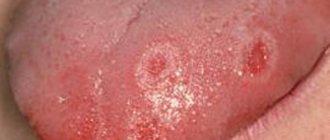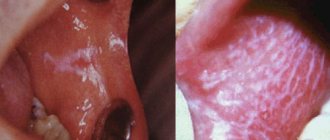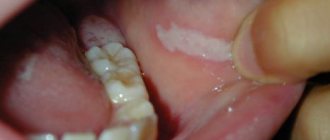- Risk factors for developing lip cancer
- Pathomorphology
- Diagnosis of lip cancer
- Prognostic factors
- Clinical picture
- Lip cancer treatment
- Disease prognosis
- Rehabilitation
- Prevention of lip cancer
Lip cancer is a malignant tumor of the stratified squamous epithelium of the red border of the lower and upper lips. Cancer of the upper lip in relation to cancer of the lower lip is 2-5% and is observed more often in women.
In the structure of incidence in relation to all malignant tumors, lip cancer is 1.8% in men and 0.53% in women. Among the CIS countries, this figure is the highest in Tajikistan: 2.7% for men and 1.5% for women, the lowest is for men in Azerbaijan - 0.6% and women in Armenia - 0.4%.
The standardized incidence rates for lip cancer in Russia in 2000 for men were 5.7; for women – 1.6; and the average age of sick men is 64.6 years; women – 72.3 years. During the period from 1990 to 2000, the incidence of lip cancer decreased from 7.5 to 4.6 in men and from 1.1 to 0.73 in women per 100 thousand inhabitants of Russia.
Risk factors for developing lip cancer
In almost all patients, the appearance of lip cancer is preceded by various background processes and precancerous conditions of the lip mucosa. The etiological factors causing lip cancer are:
- Long-term exposure to adverse meteorological factors (solar radiation, wind, sudden fluctuations in air temperature, ionizing effects).
- Exposure to carcinogenic substances of endogenous and exogenous nature.
- Bad habits: smoking, alcohol, chewing various mixtures (us, betel, etc.).
- Injuries to the red border of the lips: mechanical: carious teeth, sharp edges of tooth roots, tartar, incorrectly made dentures, biting the lip, pressure from a tube, mouthpiece, cigarette or cigarette;
- chemical carcinogens of tobacco: compounds of arsenic, mercury, bismuth; anthracite, liquid resins, petroleum distillation products from persons of relevant professions;
- thermal: burns from hot food, cigarettes.
Depending on the pathological changes in the red border, precancerous diseases with a high frequency of malignancy (15-30%) are obligate and with a low frequency of malignancy (6-10%) - facultative, as well as background processes.
Obligate precancers: warty precancer, limited hyperkeratosis, Manganotti cheilitis.
Optional precancers: verrucous leukoplakia, keratoacanthoma, cutaneous horn, papilloma with keratinization, erosive-ulcerative and hyperkeratotic forms of lupus erythematosus and lichen planus, post-radiation cheilitis.
Background processes: flat leukoplakias, chronic ulcers and fissures of the lips, atmospheric and actinic cheilitis.
Treatment of cheilitis, lupus erythematosus and lichen planus is medicinal with mandatory microscopic monitoring if there is no effect.
Treatment of other pathological changes is carried out by cryogenic, surgical, laser and photodynamic therapy.
Types of stomatitis
- Viral.
Infection with the Epstein-Bar virus or herpes simplex. It appears in the form of bubbles, in place of which erosion subsequently occurs. - Bacterial.
Caused by the proliferation of streptococci and staphylococci. It looks like pustules turning into wounds. - Fungal.
Decreased immunity and proliferation of Candida fungi. It looks like small foci of white plaque, after damage to which painful erosions remain. - Chemical.
Burns from acids and alkalis. Deep ulcers with the formation of scars and deformations of the mucosa. - Ray.
Arising as a result of exposure to ionizing radiation. Expressed in the form of erosions and tissue deformations. - Allergic.
Occurs as a reaction to medication or dentures.
Pathomorphology
Depending on the type of tumor growth, papillary and warty, as well as ulcerative and ulcerative-infiltrative forms of lip cancer are distinguished.
In 95% of cases it is squamous cell keratinizing cancer, in 5% it is squamous cell non-keratinizing cancer, characterized by a more malignant course (infiltrative growth and early metastasis to regional lymph nodes).
Depending on the prevalence of the tumor process, the stage of cancer is determined - from 0 to IV, which is taken into account when developing a treatment plan and assessing the prognosis (outcome) of the disease.
Diagnosis of lip cancer
In 2000 in Russia, 16% of patients with lip cancer were diagnosed in stages III-IV.
Reasons for delayed diagnosis: lack of oncological alertness among doctors of the general medical network, insufficient sanitary and educational work in a number of regions with a low culture of the population and, in connection with this, late access to a doctor.
If there are pathological changes on the red border, a mandatory set of diagnostic measures should include:
- study of complaints and history of the disease (duration of changes, dynamics, effectiveness of treatment);
- examination and palpation (palpation) of the lesion and regional (nearby) lymph nodes;
- taking fingerprint smears or scrapings from the surface of ulcerations, cracks, and punctate lip seals without signs of ulceration for microscopic examination. If necessary, a biopsy (taking a piece of tissue) should be performed to clarify the diagnosis.
- ultrasound examination (ultrasound) of the lymph nodes of the neck;
- differential diagnosis with tuberculosis and syphilis.
When the diagnosis of lip cancer is confirmed, an X-ray examination of the chest organs, general clinical and laboratory examination (ECG, blood tests, urine tests, etc.) are performed.
Prognostic factors
Prognosis (outcome) factors for lip cancer are:
- prevalence of the process (size of the primary tumor, presence of metastases);
- clinical and anatomical form of cancer growth (exophytic forms proceed more favorably);
- morphological type of cancer (the non-keratinizing type is more aggressive);
- nature of tumor growth (primary or recurrent);
- age (patients under 40 years of age have a more malignant course).
The prognosis for lip cancer is generally favorable.
A worsening prognosis is associated with locally widespread infiltrative growth and significant regional and distant metastasis.
Clinical picture
Symptoms of lip cancer are varied and are determined by previous precancerous diseases and the morphological type of tumor.
In the early stages, a small roller-like rim appears around the edges around the compaction or erosion, which indicates a malignant process.
Papilloma, cutaneous horn, focus of verrucous leukoplakia, warty or nodular precancer develop into exophytic forms of cancer. The process lasts a long time, the infiltration of the underlying tissues increases gradually.
Destructive forms of dyskeratosis, Mangannotti cheilitis, and other ulcerative processes develop into endophytic forms of cancer - ulcerative and ulcerative-infiltrative.
In later stages, the boundaries between the clinical and anatomical forms of cancer are blurred. If untreated, the bottom of the ulcer reaches the muscle layer, tumor infiltration spreads to the entire lip, chin tissue, floor of the mouth, cheeks, and lower jaw.
Tissue breakdown intensifies, secondary infection occurs, nutrition is disrupted, and exhaustion develops.
Lip cancer is characterized by lymphogenous metastasis.
Metastases can develop on both sides (25%). Metastasis of cancer of the lower lip at stage I is observed in 2-6% of cases, at stage II - in 15-20%, at stage III - in 35% and at stage IV - in 70% of cases.
Distant metastases of lower lip cancer are rare (2%), mainly to the lungs.
Cancer of the upper lip, as a rule, is more malignant due to the characteristics of lymph circulation and metastasis.
What can stomatitis tell you?
The appearance of stomatitis may indicate the appearance of some more serious pathologies in the body. Sometimes stomatitis is a concomitant symptom of conditions such as:
- Received ionizing radiation or chemotherapy.
- Oncological diseases of the nasopharynx, mouth, neck.
- Disorders of the digestive tract, intestinal parasites.
- HIV infection.
- Prolonged dehydration.
- Hormonal disorders in women.
- Diabetes.
- Anemia.
- Bronchial asthma.
Lip cancer treatment
The choice of treatment method depends mainly on the extent of the process (stage) and the type of tumor growth.
It is necessary to take into account the patient's age and the presence of concomitant pathology. Treatment consists of influencing the primary focus and areas of regional metastasis.
In stages I-II, cure for lip cancer can be achieved by several methods:
The cryogenic method is the effect of liquid nitrogen with a boiling point of -196 degrees C on the tumor. This method is the most effective with 100% cure, functionally sparing, because indicated for elderly people and those suffering from severe concomitant pathologies; it can be used once on an outpatient basis.
Radiation method – close-focus X-ray therapy (50-65 Gy), interstitial radiation therapy (50-70 Gy), electron therapy (SOD 50-70 Gy).
The surgical method is used when it is impossible to use cryogenic or radiation treatment.
Photodynamic therapy is laser exposure against the background of local or intravenous administration of a photosensitizing drug for limited superficial lesions.
Preventive surgery on the neck in stages I-II is indicated only if there is no possibility of dynamic observation by an oncologist in patients with unfavorable prognosis factors (young men, non-keratinizing type of squamous cell carcinoma, infiltrative growth form).
In stage III without metastases in regional lymph nodes, treatment can be carried out:
Cryogenic method , using cryoapplication, cryo-irrigation or a combination thereof. Preventive surgery on the neck is performed for the same indications as stages I-II.
Neck surgery can be performed simultaneously with cryogenic exposure.
Radiation method (combined radiation treatment at 60-70 Gy). The zone of radiation exposure includes areas of regional metastasis.
Combined method (preoperative gamma therapy with a dose of 40-50 Gy on the primary tumor and areas of regional metastasis, followed by surgery.
For locally advanced lip cancer without metastases or with single metastases in regional lymph nodes (stage IV), combined treatment followed by extended surgery and primary or delayed plastic surgery is possible.
Chemotherapy is carried out with platinum drugs , fluorouracil , methotrexate , bleomycin .
For limited recurrences of lip cancer, surgical or cryogenic treatment is indicated.
In case of widespread relapses, it is possible to perform extended surgical interventions with simultaneous plastic surgery.
Symptoms of stomatitis
Stomatitis can be recognized by a number of symptoms, the most common of which are:
- Redness with swelling and pain.
- Subsequent formation of ulcers with a smooth edge under a thin film (with bacterial stomatitis).
- Burning and pain at the site of the lesion.
- Increased salivation, characteristic odor from the mouth.
- Bleeding gums.
- Increased temperature, local or throughout the body.
- The appearance of ulcers is often concentrated on the inside of the lips; it is also possible to affect the area under the tongue, the tongue and gums, and the inner surface of the cheeks.
Prevention of lip cancer
- Preventive examinations of the population, clinical examination of persons constituting a high-risk group, sanitary and educational work.
- Carrying out hygienic measures, sanitation of the oral cavity, adequate prosthetics.
- Treatment of underlying diseases, precancerous changes in the mucous membrane: the use of indifferent ointments and hygienic lip protection products in persons whose profession is associated with harmful effects on the lips and are exposed to prolonged adverse meteorological factors;
- giving up bad habits (smoking, eating chewing mixtures that irritate the mucous membrane of the lips) and eliminating harmful environmental factors;
- normalization of gastrointestinal tract function, increased immunity.
Causes of stomatitis
There are several reasons that provoke stomatitis:
- The addition of infection is viruses and bacteria, which very quickly colonize, revealing damaged areas of the mucous membrane.
- Poor nutrition – if the diet is too poor, the body does not have enough strength and resources to fight the pathogens attacking it.
- Wounds and other injuries in the mouth - these can be scratches from sharp edges of teeth with carious cavities, bitten cheeks, cracked lips, burns.
- Improper oral hygiene - insufficient cleaning leaves plaque on the tooth and tongue, in which bacteria multiply very quickly.
- Insufficient hygiene in general - dirty hands, unwashed fruits, which become sources of bacteria.
- Consequences of dental intervention performed in violation of norms.
- Using pastes with sodium lauryl sulfate, which reduces salivation. In such a situation, the epithelium may dry out and, as a result, not be sufficiently resistant to bacteria.
- Alcohol and smoking.
- Chronic diseases of a general nature that affect the state of the body, digestion of food, and other vital processes.










